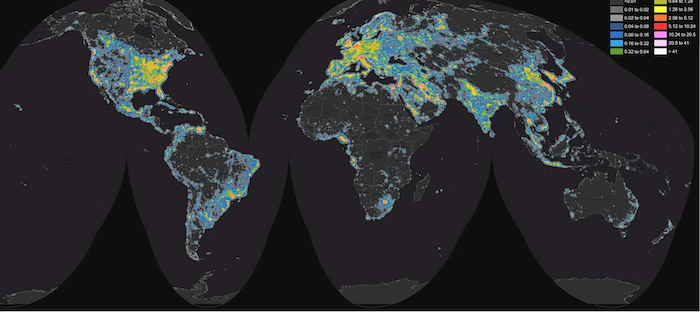by Brianna Crandall — August 31, 2016 — With applications for facilities managers in charge of choosing and/or managing the outdoor lighting of their corporate or educational campuses, a groundbreaking new study documenting “light pollution,” or artificial sky brightness, across the globe finds that more than 80 percent of the world’s population lives under “light-polluted” skies. The United States and Europe have it even worse, with 99 percent of their denizens experiencing skyglow at night.
The new “World Atlas of Artificial Night Sky Brightness,” published in the open-access journal Science Advances, is a welcome follow up to the 2001 “World Atlas” and is sure to benefit researchers across multiple disciplines, says the International Dark-Sky Association.

World map of artificial sky brightness. Image from the new “World Atlas of Artificial Night Sky Brightness.”
Scott Feierabend, IDA executive director, hailed the work as a major breakthrough, saying, “The new atlas acts as a benchmark, which will help to evaluate the success or failure of actions to reduce light pollution in urban and natural areas.”
The atlas documents a world that is in many places awash with light. In Western Europe, only a few small areas remain where the night sky remains relatively unpolluted, including areas in Scotland, Sweden, Norway, and parts of Spain and Austria. In addition to a world map, researchers provide tables of each country and what fraction of its population live under highly light polluted skies.
The authors specifically examined the G20 countries, finding that in terms of area, Italy and South Korea are the most polluted, and Canada and Australia have the least skyglow. Residents of India and Germany are most likely to be able to see the Milky Way from their home, while those in Saudi Arabia and South Korea are least likely.
According to the study’s authors, “Humanity has enveloped our planet in a luminous fog that prevents most of Earth’s population from having the opportunity to observe our galaxy. This has a consequent potential impact on culture that is of unprecedented magnitude.”
Study confirms IDA’s stance on outdoor lighting and LEDs
According to the study, street lighting and outdoor lighting retrofits using 4000K lamps (IDA recommends 3000K or below) could result in a 2.5 increase in light pollution. This is because sources with higher color temperatures are more polluting, says IDA. The researchers warn that that unless careful consideration is given to LED color and lighting levels and blue-light emissions are restricted, the current worldwide transition to light-emitting diode (LED) technology to save energy may only exacerbate the problem (See the IDA LED Practical Guide).
To decrease light pollution, the authors prescribe full shielding of lighting, using the minimum light needed for the tasks, shutting off or lowering light levels when not in use, decreasing the total installed flux and limiting “blue” light (light with higher color temperatures).
Major advances over the 2001 atlas were possible thanks to a new satellite and to the recent development of inexpensive sky radiance meters, and the engagement of citizen scientists was said to be critical. Led by Fabio Falchi from the Italian Light Pollution Science and Technology Institute, researchers hailed from Italy, Germany, the USA, and Israel, and were affiliated with the U.S. National Oceanic and Atmospheric Administration (NOAA), U.S. National Park Service, GFZ German Research Centre for Geosciences, and the University of Haifa.
Access the free online version of the “World Atlas of Artificial Night Sky Brightness” from the Science Advances journal.





